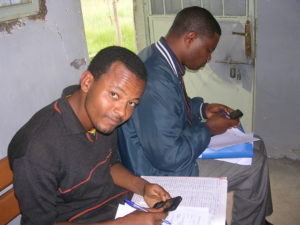
By Megan Noel, SC4CCM M&E Technical Advisor
NOTE: This post originally appeared on JSI.com
Evaluators in the 21st century have access to a multitude of innovative technologies for improving the efficiency and quality of data they collect. Mobile data collection has been used in the most remote and surprising settings, from rural Malawi to hospital delivery rooms, and experience from recent years proves this technology is here to stay. Examples of the successes (and pitfalls) of using mobile devices for data collection will help to shape this field as technology evolves and moves in new directions.
The Supply Chains for Community Case Management of Common Childhood Illnesses (SC4CCM) project set out to identify, demonstrate, and institutionalize various supply chain management practices in Ethiopia, Malawi, and Rwanda to improve the availability and use of selected essential health products in community-based programs. To do this, our team needed to understand how supply chains move life-saving drugs from national warehouses to hard-to-reach communities, and the challenges faced by community health workers in order to keep a constant supply of drugs on hand.

Data collectors in Ethiopia practice using mobile phones for the 2010 baseline assessment.
To understand complex issues like these and set up a baseline for evaluating the project’s work, we needed to visit locations from capital cities down to districts, health centers, and community health workers. The volume of data posed a mounting challenge in terms of time and resources, and the project found that using Episurveyor software, created by Data Dyne, offered an innovative low-cost answer to the persistent issue of slow, paper-based, and hard to manage surveys. SC4CCM decided to test this new mobile approach for three large quantitative baseline assessments in the project’s focal countries.
Learning how to use this new platform was time-consuming, and we faced a number of challenges while getting our baselines off the ground. Nevertheless, we learned to adapt survey questions to the mobile format, use the technology in variable network settings, and plan adequate time for training, piloting, editing forms and double checking functionality. Mobile data capture offered the opportunity to monitor data quality remotely with data collectors still in the field, and avoid the time-consuming data entry process between collection and analysis. Despite pitfalls, the project saved months of man hours normally needed to manage and carry out data entry, and used time savings to generate and act on survey findings more quickly. Data Dyne also readily accepted feedback from our experiences and used it to update the software to its latest version, now called Magpi (www.magpi.com).
Over the past four years, SC4CCM has conducted 6 major surveys and monitoring activities using mobile across three countries. When we started in 2010, we did not know we were contributing to a changing standard for survey data collection across our organization. JSI, a global leader in public health and development projects all over the world, now routinely uses mobile data collection tools across the organization, from small learning grants to high-volume assessments. As an M&E Advisor, I am excited to continue watching this software and others like it evolve and improve, as the quality and efficiency of the data we collect will certainly continue to improve with it.

